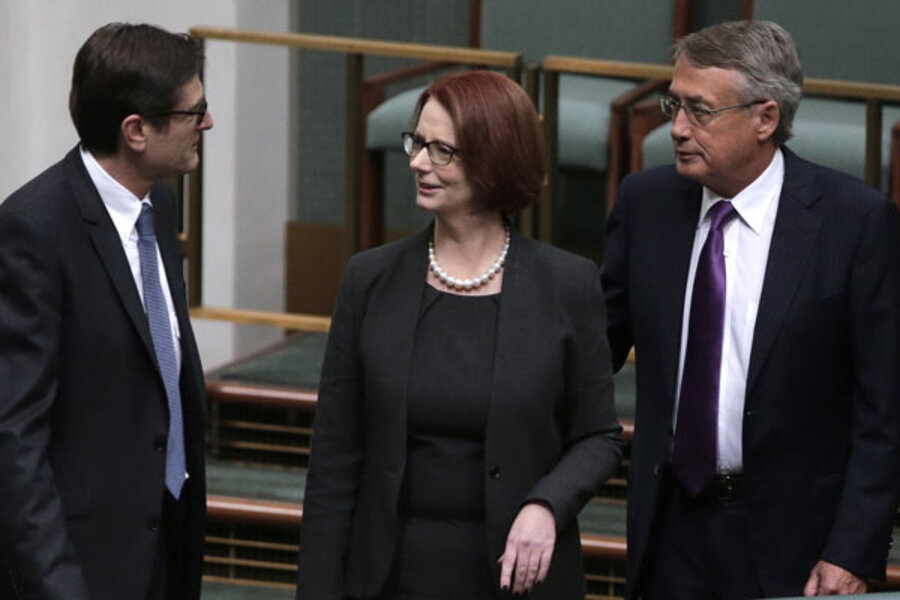Australia asks: Are we sexist?
Loading...
| Sydney, Australia
In the weeks since Australia’s first female prime minister, Julia Gillard, was unceremoniously ousted in June, her departure has touched off a wider debate in this Asian-Pacific nation: Is Australia sexist?
The answer, say analysts, is complicated. They say gender doesn’t wholly explain Prime Minister Gillard’s exit. Unpopular policy and party factionalism was ultimately to blame. However, her experience highlighted a crude undercurrent of gender bias in Australia.
“At a macro level, I think it would be widely considered that Australian women are equal to men in politics,” says Lauren Rosewarne, a political scientist focused on gender issues at Australia’s University of Melbourne.
“They, at least theoretically, have the same capacity to enter politics as men. Practically, however, there are many structural barriers that make the journey of women in politics more complicated.”
On the face of it, Aussie women are faring better than ever. They often outshine their overseas counterparts, with the nation ranking first among the Organization for Economic Cooperation and Development (OECD) countries for its number of educated women.
In global terms, they are also quite powerful. Women make up almost a quarter of the country’s House of Representatives, 22 percent of senior positions at law firms, and 14 percent of Australia’s stock exchange.
Yet they work hard to get to these privileged positions. Australian women are still overwhelmingly the primary caregiver, and climbing the career ladder can sometimes get sidelined for looking after the children.
“Politics is an incredibly time-consuming game that requires extensive periods away from home. If a woman has a family, juggling both is much more difficult for her than a man,” says Dr. Rosewarne.
Global issues like this are also affecting Australian women outside the political sphere. Despite their legally protected equality of opportunity, the latest research makes it clear that one half of the country’s population experiences entrenched disadvantage in the workplace.
For example, a workplace management survey released last week by a workplace management consultancy, Kronos, found that the majority of Australian businesses still prefer to hire men (without children or relationships) over women.
Another report by the Committee for Economic Development of Australia (CEDA) concluded last month that “progress towards gender equality basically halted” in Australia by the end of last century, with pay differences between the sexes actually getting worse since 2005.
Why?
In 2013, Australian women on average receive 17.5 percent less than men to perform the same roles at the same level. The CEDA report concludes “the majority of [this] pay gap is explained by gender alone.”
Of course, it could be worse. While the overall gender pay gap for Europe is lower at 16.2 percent, the United Kingdom is more than 20 percent. Austria and Germany have hit 23.7 and 22.2 percent respectively.
Yet statistics do not paint the whole picture.
“Australia does have a sexism problem. We don’t deal well with powerful women. I think both sexism and racism are worse now that they were a decade or more ago,” says Eva Cox, an Australian political commentator.
Australian media and political propaganda, though difficult to measure, strongly indicate a negative undertone toward women. Ms. Cox says there’s anecdotal evidence of a revived misogyny in public discourse since the 1990s.
“There is much cruder and ruder public discourse on political issues. A mix of online freedom to be obnoxious and debates about political correctness seem to suggest that civility is no longer even a public debate,” she says.
Australia is known for its irreverently bold and brash undertone that often makes crude jokes at the expense of public figures’ appearance or mannerisms. That “Blokey Culture” also affects how Australians treat one another, says Cox.
It’s not just women who are affected by this culture. For instance, former Prime Minister John Howard was notoriously mocked for his eyebrows. However, analysts say there’s evidence that women are insulted in a way more wholly directed to their gender.
Analysts say feminism has stalled both in Australia and worldwide since the 1990s, and that crudeness at the expense of a woman’s disadvantage has become more acceptable.
For example, says Rosewarne, when Gillard ousted Kevin Rudd in 2010, this was framed by the media as an act of “backstabbing.” That’s a “very gendered accusation,” she says.
Gillard also received insults from the opposition party about her female body parts in ways that would be generally unacceptable to talk about male body parts, or a politician’s skin color.
“What message is being conveyed to our daughters when being female is the weakness; is the Achilles’ heel?” asked one prominent Australian writer, Anna Goldsworthy, in her essay “Unfinished Business” in June.







